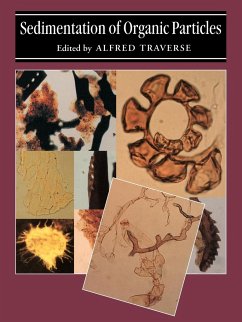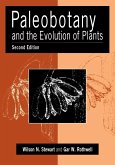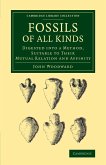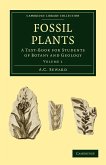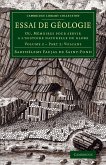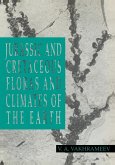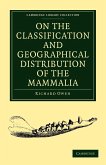- Broschiertes Buch
- Merkliste
- Auf die Merkliste
- Bewerten Bewerten
- Teilen
- Produkt teilen
- Produkterinnerung
- Produkterinnerung
This book presents research work on the sedimentation of components of palynofacies and details their importance for sequence stratigraphy and the interpretation of ancient biologic and geologic environments. After a comprehensive introduction, later chapters look at palynosedimentation in modern environments, the reconstruction of terrestrial vegetation, the application of the data to sequence stratigraphy and several chapters deal with various quantitative methods and their specific applications in the subject.
Andere Kunden interessierten sich auch für
![The Fossils of the Hunsruck Slate The Fossils of the Hunsruck Slate]() Christoph BartelsThe Fossils of the Hunsruck Slate74,99 €
Christoph BartelsThe Fossils of the Hunsruck Slate74,99 €![Paleobotany and the Evolution of Plants Paleobotany and the Evolution of Plants]() Wilson N. StewartPaleobotany and the Evolution of Plants82,99 €
Wilson N. StewartPaleobotany and the Evolution of Plants82,99 €![Fossils of All Kinds Fossils of All Kinds]() John WoodwardFossils of All Kinds35,99 €
John WoodwardFossils of All Kinds35,99 €![Fossil Plants - Volume 1 Fossil Plants - Volume 1]() A. C. SewardFossil Plants - Volume 157,99 €
A. C. SewardFossil Plants - Volume 157,99 €![Essai de Geologie Essai de Geologie]() B. Faujas-De-St -FondEssai de Geologie46,99 €
B. Faujas-De-St -FondEssai de Geologie46,99 €![Jurassic and Cretaceous Floras and Climates of the Earth Jurassic and Cretaceous Floras and Climates of the Earth]() V. A. VakhrameevJurassic and Cretaceous Floras and Climates of the Earth60,99 €
V. A. VakhrameevJurassic and Cretaceous Floras and Climates of the Earth60,99 €![On the Classification and Geographical Distribution of the Mammalia On the Classification and Geographical Distribution of the Mammalia]() Richard OwenOn the Classification and Geographical Distribution of the Mammalia34,99 €
Richard OwenOn the Classification and Geographical Distribution of the Mammalia34,99 €-
-
-
This book presents research work on the sedimentation of components of palynofacies and details their importance for sequence stratigraphy and the interpretation of ancient biologic and geologic environments. After a comprehensive introduction, later chapters look at palynosedimentation in modern environments, the reconstruction of terrestrial vegetation, the application of the data to sequence stratigraphy and several chapters deal with various quantitative methods and their specific applications in the subject.
Hinweis: Dieser Artikel kann nur an eine deutsche Lieferadresse ausgeliefert werden.
Hinweis: Dieser Artikel kann nur an eine deutsche Lieferadresse ausgeliefert werden.
Produktdetails
- Produktdetails
- Verlag: Cambridge University Press
- Seitenzahl: 560
- Erscheinungstermin: 13. Mai 2005
- Englisch
- Abmessung: 280mm x 210mm x 30mm
- Gewicht: 1352g
- ISBN-13: 9780521675505
- ISBN-10: 0521675502
- Artikelnr.: 21364060
- Herstellerkennzeichnung
- Libri GmbH
- Europaallee 1
- 36244 Bad Hersfeld
- gpsr@libri.de
- Verlag: Cambridge University Press
- Seitenzahl: 560
- Erscheinungstermin: 13. Mai 2005
- Englisch
- Abmessung: 280mm x 210mm x 30mm
- Gewicht: 1352g
- ISBN-13: 9780521675505
- ISBN-10: 0521675502
- Artikelnr.: 21364060
- Herstellerkennzeichnung
- Libri GmbH
- Europaallee 1
- 36244 Bad Hersfeld
- gpsr@libri.de
Part I. Introduction: 1. Sedimentation of palynomorphs and palynodebris: an
introduction; Part II. Studies of Palynosedimentation in Modern
Environments: A. Palynomorph sedimentation; 2. The sorting of spores and
pollen by water: experimental and field evidence; 3. Transport and
deposition of pollen in an estuary: signature of the landscape; 4. Pollen
preservation in alkaline soils of the American Southwest; 5. Wind and water
transport and sedimentation of miospores along two rivers subject to major
floods and entering the Mediterranean Sea at Calvi (Corsica, France); 6.
Sedimentation of land-derived palynomorphs in the Trinity-Galveston Bay
area, Texas; B. Palynofacies and palynodebris sedimentation; 7. The genesis
and sedimentation of phytoclasts with examples from coastal environments;
8. Palynofacies of some recent marine sediments: the role of
transportation; 9. Maceral palynofacies of the Louisiana deltaic plain in
terms of organic constituents and hydrocarbon potential; 10. Organic
sedimentation in a carbonate region; 11. An approach to a standard
terminology for palynodebris; 12. Relationships of palynofacies to
coal-depositional environments of the upper Paleocene of the Gulf Coast
basin, Texas, and the Powder River basin, Montana and Wyoming; Part III.
Reconstruction of Late Cenozoic Vegetation and Sedimentary Environments
from Palynological Data: 13. Quaternary terrestrial sediments and spatial
scale: the limits to interpretation; 14. Pollen and spores in Quaternary
lake sediments as sensors of vegetation composition: theoretical models and
empirical evidence; 15. Paleoecological interpretation of the Trail Ridge
sequence, and related deposits in Georgia and Florida, based on pollen
sedimentation and clastic sedimentology; Part IV. Application of Data on
Palynosedimentation to Solution of Geological Problems: A. Sedimentary
cycles: 16. Polynology of sedimentary cycles; B. Sequence stratigraphy and
sedimentation of organic particles; 17. Particulate organic matter, maceral
facies models, and applications to sequence stratigraphy; C. Quantitative
methods and applications thereof; 18. Association of palynomorphs and
palynodebris with depositional environments: quantitative approaches; 19. A
quantitative approach to Triassic palynology: the Lettenkeuper of the
Germanic Basin as an example; 20. Palynomorph concentration in studies of
Paleogene nonmarine depositional environments of Wyoming; D. Specific
examples of applications; 21. Multivariate analyses of palynomorph data;
22. Relationships between depositional environments and changes in
palynofloras across the K-T boundary interval; 23. Sedimentation of
palynomorphs in rocks of pre-Devonian age; Part V. Appendix: modern pollen
transport and sedimentation: an annotated bibliography.
introduction; Part II. Studies of Palynosedimentation in Modern
Environments: A. Palynomorph sedimentation; 2. The sorting of spores and
pollen by water: experimental and field evidence; 3. Transport and
deposition of pollen in an estuary: signature of the landscape; 4. Pollen
preservation in alkaline soils of the American Southwest; 5. Wind and water
transport and sedimentation of miospores along two rivers subject to major
floods and entering the Mediterranean Sea at Calvi (Corsica, France); 6.
Sedimentation of land-derived palynomorphs in the Trinity-Galveston Bay
area, Texas; B. Palynofacies and palynodebris sedimentation; 7. The genesis
and sedimentation of phytoclasts with examples from coastal environments;
8. Palynofacies of some recent marine sediments: the role of
transportation; 9. Maceral palynofacies of the Louisiana deltaic plain in
terms of organic constituents and hydrocarbon potential; 10. Organic
sedimentation in a carbonate region; 11. An approach to a standard
terminology for palynodebris; 12. Relationships of palynofacies to
coal-depositional environments of the upper Paleocene of the Gulf Coast
basin, Texas, and the Powder River basin, Montana and Wyoming; Part III.
Reconstruction of Late Cenozoic Vegetation and Sedimentary Environments
from Palynological Data: 13. Quaternary terrestrial sediments and spatial
scale: the limits to interpretation; 14. Pollen and spores in Quaternary
lake sediments as sensors of vegetation composition: theoretical models and
empirical evidence; 15. Paleoecological interpretation of the Trail Ridge
sequence, and related deposits in Georgia and Florida, based on pollen
sedimentation and clastic sedimentology; Part IV. Application of Data on
Palynosedimentation to Solution of Geological Problems: A. Sedimentary
cycles: 16. Polynology of sedimentary cycles; B. Sequence stratigraphy and
sedimentation of organic particles; 17. Particulate organic matter, maceral
facies models, and applications to sequence stratigraphy; C. Quantitative
methods and applications thereof; 18. Association of palynomorphs and
palynodebris with depositional environments: quantitative approaches; 19. A
quantitative approach to Triassic palynology: the Lettenkeuper of the
Germanic Basin as an example; 20. Palynomorph concentration in studies of
Paleogene nonmarine depositional environments of Wyoming; D. Specific
examples of applications; 21. Multivariate analyses of palynomorph data;
22. Relationships between depositional environments and changes in
palynofloras across the K-T boundary interval; 23. Sedimentation of
palynomorphs in rocks of pre-Devonian age; Part V. Appendix: modern pollen
transport and sedimentation: an annotated bibliography.
Part I. Introduction: 1. Sedimentation of palynomorphs and palynodebris: an
introduction; Part II. Studies of Palynosedimentation in Modern
Environments: A. Palynomorph sedimentation; 2. The sorting of spores and
pollen by water: experimental and field evidence; 3. Transport and
deposition of pollen in an estuary: signature of the landscape; 4. Pollen
preservation in alkaline soils of the American Southwest; 5. Wind and water
transport and sedimentation of miospores along two rivers subject to major
floods and entering the Mediterranean Sea at Calvi (Corsica, France); 6.
Sedimentation of land-derived palynomorphs in the Trinity-Galveston Bay
area, Texas; B. Palynofacies and palynodebris sedimentation; 7. The genesis
and sedimentation of phytoclasts with examples from coastal environments;
8. Palynofacies of some recent marine sediments: the role of
transportation; 9. Maceral palynofacies of the Louisiana deltaic plain in
terms of organic constituents and hydrocarbon potential; 10. Organic
sedimentation in a carbonate region; 11. An approach to a standard
terminology for palynodebris; 12. Relationships of palynofacies to
coal-depositional environments of the upper Paleocene of the Gulf Coast
basin, Texas, and the Powder River basin, Montana and Wyoming; Part III.
Reconstruction of Late Cenozoic Vegetation and Sedimentary Environments
from Palynological Data: 13. Quaternary terrestrial sediments and spatial
scale: the limits to interpretation; 14. Pollen and spores in Quaternary
lake sediments as sensors of vegetation composition: theoretical models and
empirical evidence; 15. Paleoecological interpretation of the Trail Ridge
sequence, and related deposits in Georgia and Florida, based on pollen
sedimentation and clastic sedimentology; Part IV. Application of Data on
Palynosedimentation to Solution of Geological Problems: A. Sedimentary
cycles: 16. Polynology of sedimentary cycles; B. Sequence stratigraphy and
sedimentation of organic particles; 17. Particulate organic matter, maceral
facies models, and applications to sequence stratigraphy; C. Quantitative
methods and applications thereof; 18. Association of palynomorphs and
palynodebris with depositional environments: quantitative approaches; 19. A
quantitative approach to Triassic palynology: the Lettenkeuper of the
Germanic Basin as an example; 20. Palynomorph concentration in studies of
Paleogene nonmarine depositional environments of Wyoming; D. Specific
examples of applications; 21. Multivariate analyses of palynomorph data;
22. Relationships between depositional environments and changes in
palynofloras across the K-T boundary interval; 23. Sedimentation of
palynomorphs in rocks of pre-Devonian age; Part V. Appendix: modern pollen
transport and sedimentation: an annotated bibliography.
introduction; Part II. Studies of Palynosedimentation in Modern
Environments: A. Palynomorph sedimentation; 2. The sorting of spores and
pollen by water: experimental and field evidence; 3. Transport and
deposition of pollen in an estuary: signature of the landscape; 4. Pollen
preservation in alkaline soils of the American Southwest; 5. Wind and water
transport and sedimentation of miospores along two rivers subject to major
floods and entering the Mediterranean Sea at Calvi (Corsica, France); 6.
Sedimentation of land-derived palynomorphs in the Trinity-Galveston Bay
area, Texas; B. Palynofacies and palynodebris sedimentation; 7. The genesis
and sedimentation of phytoclasts with examples from coastal environments;
8. Palynofacies of some recent marine sediments: the role of
transportation; 9. Maceral palynofacies of the Louisiana deltaic plain in
terms of organic constituents and hydrocarbon potential; 10. Organic
sedimentation in a carbonate region; 11. An approach to a standard
terminology for palynodebris; 12. Relationships of palynofacies to
coal-depositional environments of the upper Paleocene of the Gulf Coast
basin, Texas, and the Powder River basin, Montana and Wyoming; Part III.
Reconstruction of Late Cenozoic Vegetation and Sedimentary Environments
from Palynological Data: 13. Quaternary terrestrial sediments and spatial
scale: the limits to interpretation; 14. Pollen and spores in Quaternary
lake sediments as sensors of vegetation composition: theoretical models and
empirical evidence; 15. Paleoecological interpretation of the Trail Ridge
sequence, and related deposits in Georgia and Florida, based on pollen
sedimentation and clastic sedimentology; Part IV. Application of Data on
Palynosedimentation to Solution of Geological Problems: A. Sedimentary
cycles: 16. Polynology of sedimentary cycles; B. Sequence stratigraphy and
sedimentation of organic particles; 17. Particulate organic matter, maceral
facies models, and applications to sequence stratigraphy; C. Quantitative
methods and applications thereof; 18. Association of palynomorphs and
palynodebris with depositional environments: quantitative approaches; 19. A
quantitative approach to Triassic palynology: the Lettenkeuper of the
Germanic Basin as an example; 20. Palynomorph concentration in studies of
Paleogene nonmarine depositional environments of Wyoming; D. Specific
examples of applications; 21. Multivariate analyses of palynomorph data;
22. Relationships between depositional environments and changes in
palynofloras across the K-T boundary interval; 23. Sedimentation of
palynomorphs in rocks of pre-Devonian age; Part V. Appendix: modern pollen
transport and sedimentation: an annotated bibliography.

